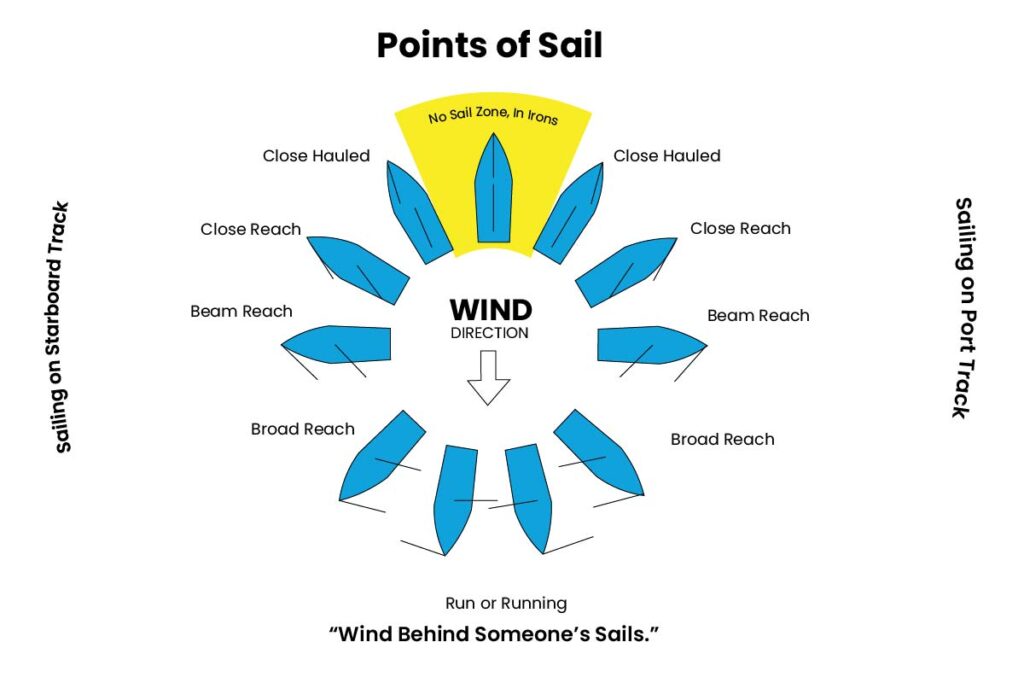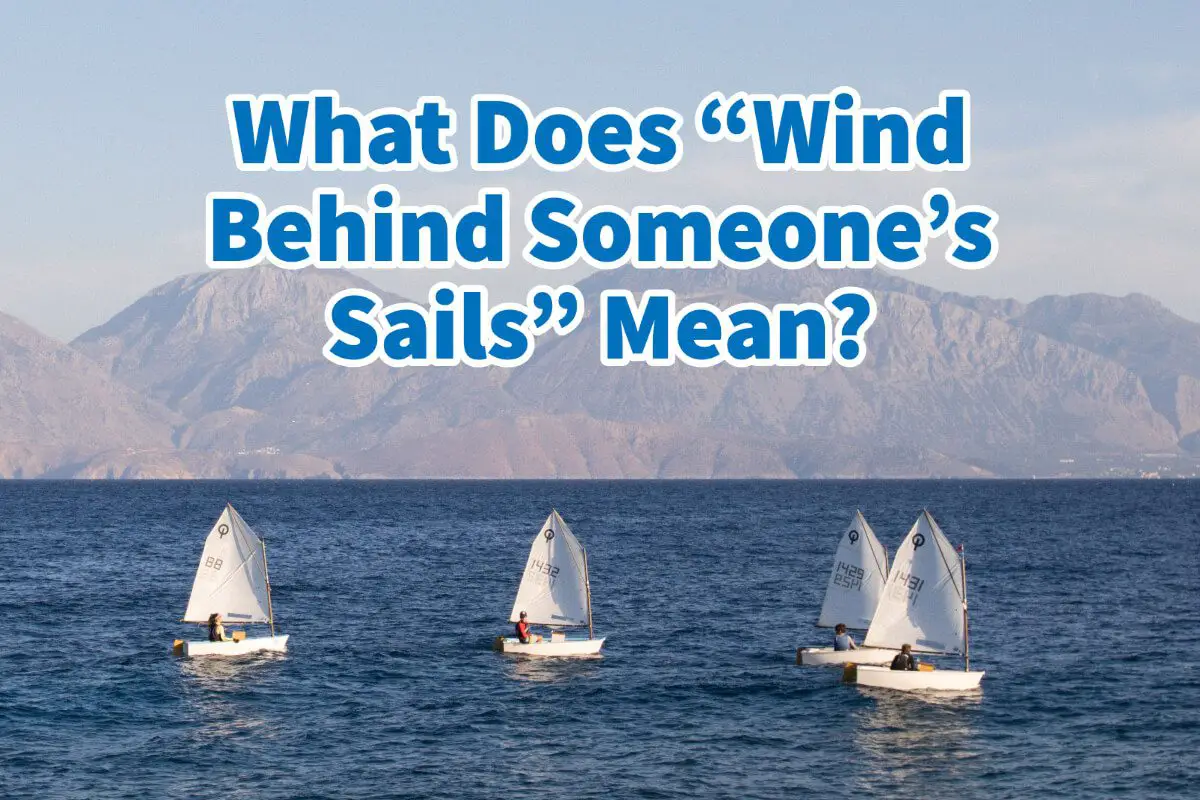There is a term or expression that many people use called the “wind behind someone’s sail,” or they have “the wind behind their sail.”
The “wind behind someone’s sail “refers to moving forward with the wind when sailing if the wind is behind you or you are sailing on the run point of sail. On the run point of sail, your sail is out, and the wind will move your forward; the idiom, “wind behind someone’s sail,” refers to being able to move in the right direction on the run point of sail or when the wind is blowing from behind the sailboat.
Table of Contents
- The Wind Behind Your Sails Idiom Meaning
- The Points of Sail And Why They Are Important
- Frequently Asked Questions
- Related Questions
The Wind Behind Your Sails Idiom Meaning
When the wind is behind you, the sailing point is a run or running. A point in sail has to do with the direction of the wind and where and how your sails are pointed.
In the point of sail for a run, the wind is right behind you, or at your back, your sails are out, and the wind is blowing into the sails.
This could be a fast way to sail your boat for some kinds of boats, but this is not the quickest point of sailing for other boats. Whether or not a run is the fastest point of sail for a boat depends on what type of boat you are sailing.
The expression of “wind behind someone’s sail” refers to the run point of the sail and the fact that the boat or this individual is moving forward with the wind blowing from the back.
Here are some things to “get the wind behind someone’s sail” means:
- Moving Forward – Just like the boat that can sail forward with the wind behind them as the wind goes into the sails and pushes the boat forward, this idiom also means someone is moving forward somehow.
- Has Support – The wind supports the boat so the ship can move forward and continue sailing. When someone has the wind in their sails, it also implies that they have some support or a support system to help them go forward.
- Sailing Well – When you are sailing a point of the sail of a run, it means that you are “sailing well.” Having the wind behind you means that that individual is moving in the right direction or “sailing well.”
- Making Progress – The wind behind your sails also means that someone is progressing. It can be implied that they had some luck or outside influences, just like the wind in a sail can make a difference in how fast or slow a sailboat will travel.
- Moving Full Speed – The wind behind their sails implies that someone is moving ahead. When you are on a sailing run, and your sails are full, the sailboat does not stop, and it is almost impossible to stop without changing the sails or direction.
The idiom wind behind their sails implies that a person is moving in the right direction, just like when your point of sail is a run, the wind is blowing behind you and pushing you forward; on a run point of sail you are also sailing in the right direction and moving forward with your sailboat.

Listen To Our Podcast About What Does “The Wind Behind Someone’s Sails” Really Mean? below or by clicking here.
The Points of Sail And Why They Are Important
Different points of sail have to do with what direction the wind is coming from. The direction of the wind dictates the direction that a sailboat can sail.
Understanding the point of sail is vital to understanding how the ship will sail according to the wind’s direction. The point of sail is essential as it helps to describe and show the range, course, or way that a sailboat can or cannot travel.
Here are some of the points of sail and why they are essential.

Point of Sail – In Irons Or No Sail Zone
The Point of Sail, known as In Irons or No Sail Zone, is where you try to sail directly into the wind. It is physically impossible for a boat to sail directly into the wind.
The In irons or No Sail Zone is an approximately 90-degree dead zone where the ship is heading directly into the wind. The term, In Irons, is an idiom that means no movement and is the opposite of the “wind behind their sails.”
The term “in irons” refers to the time when prisoners on the ships were put in irons so they could not move, and so when the ship tried to sail into the wind, it was called the no sail zone as in irons; as the ship is also in shackles and cannot move forward.
Point of Sail – Close Haul
A sailboat is said to be at the close haul when the ship is sailing right near the port (left) or starboard (right) side of the no-sail zone or in irons. For a Close Haul point of sail, the sails are trimmed tightly and act as a wing to propel the sailboat forward or as close to the edge of the wind as possible.
Point of Sail – Close Reach
Point of sail for the close reach is when you sail right next to the close haul, but you are slightly further away from the close haul. The sails and jib also pulled in for the Close Reach sail but not quite as tight as the close haul.
For some boats, such as the Ensign Keelboat that I sail, the close reach can be a very fast way to sail the boat, and it is a point of sail that many people prefer when racing.
Point of Sail – Beam Reach
The point of sail for the beam reach is when the wind is going over the beam or blowing from side to side over the haul of the sailboat. For a beam reach, the sails will be out more than a close reach but not as far out as some other points of sail.
Point of Sail – Broad Reach
For the broad reach point of the sail, the wind is behind the sail but not directly behind it as in a run. The sails are out beyond the beam reach or close haul for a broad reach. The broad reach point of the sail is when the wind crosses over the stern or back part of the boat.
Point of Sail – Run
The point of sail, known as a run, is when the wind is directly behind you, and the wind is blowing at your back; The run point of sail is meant the “wind behind someone’s back.”
This can be a slower way to sail than for a close haul or close reach for some sailboats. This could be a fast way to sail the boat for other sailboats.
A sailboat can not move forward without wind, and sailing a sailboat into the no sail zone or in irons also means that your boat will not move forward. But if you have your sails out and the wind behind your back and are sailing on the run point of sail, your sailboat will move forward.
At A Bus On A Dusty Road, we talk about everything about travel, life, sailing, and ex-pat living. We are all about “Living Life As A Global Citizen.” We explore social, cultural, and economic issues and travel.
We would love to have you be part of our community. Sign up for our newsletter to keep up-to-date by clicking here. If you have any questions, you can contact me, Anita, by clicking here.
Listen to our Podcast called Dusty Roads. You can find it on all major podcast platforms. Try out to listening to one of our podcasts by clicking here.
Subscribe to our A Bus On A Dusty Road YouTube Channel with great videos and information by clicking here.
Frequently Asked Questions
What does the phrase “wind behind someone’s sails” mean?
The phrase “wind behind someone’s sails” is an idiomatic expression that refers to providing support, motivation, or favorable conditions to someone to help them succeed or make progress.
Where does the expression “wind behind someone’s sails” originate from?
The expression originates from sailing, where wind is essential for propelling a sailboat forward. It has been figuratively adopted to represent support and momentum in various contexts.
Can you give an example of how to use “wind behind someone’s sails” in a sentence?
Certainly! An example sentence would be: “With her team’s encouragement and support, she had the wind behind her sails as she pursued her ambitious goals.”
Is “wind behind someone’s sails” synonymous with luck?
While luck can play a role in success, the phrase “wind behind someone’s sails” implies more than just luck. It suggests active support or advantageous circumstances that propel someone forward.
Does having the wind behind one’s sails guarantee success?
Having the wind behind one’s sails provides an advantage, but success ultimately depends on various factors, including personal effort, skills, and external conditions beyond just support.
Can the expression be used in a negative context?
The phrase is typically used in a positive context, emphasizing support and favorable conditions. However, it could be used metaphorically to describe someone receiving unwarranted support or advantages.
Is there an opposite expression to “wind behind someone’s sails”?
While there isn’t an exact opposite expression, one could say “headwind” or “storm in one’s path” to describe facing obstacles or challenges that hinder progress.
Can “wind behind someone’s sails” be applied to both personal and professional situations?
Absolutely! The expression can be used in both personal and professional contexts to convey the idea of receiving support, encouragement, or favorable circumstances.
Related Questions
What Is The Meaning Of Port, Starboard, Bow, And Stern?
The term port means the left side of the boat, and starboard is the right side of the boat. The bow is the front side of the boat, and the stern is the back side of the boat. Each of these is a different part of the boat, and it is vital to understand when sailing a boat or driving a motorboat.
By clicking here, you can discover All About Sailing In The What Is The Meaning Of Port, Starboard, Bow, And Stern?.
How Much Wind Is Too Much For A Beginner Sailor?
For a beginner sailor, the wind is usually recommended to be under 10 knots. Those who are more experienced or with a larger boat can consider going up to 12 knots of wind. A knot is not the same as miles per hour or kilometers per hour but is faster than these measurements.
By clicking here, you can discover How Much Wind Is Too Much For A Beginner Sailor?
No Experience Sailing, 6 Tips To Get Started
If you are going to take up sailing, you first must get on a boat and find out if sailing is suitable. The best sailors can handle their boats in all kinds and types of weather. Find a class that you can join and get certified. Sailing requires knowledge and skill. Find yourself a sailing community that you can be part of.
By clicking here, you can discover No Experience Sailing, 6 Tips To Get Started.

